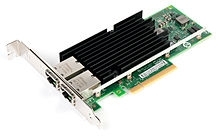- Related articles
- Best-selling models of Intel Ethernet server adapters
- Optical Transceivers for Cisco N7K-F348XP-25= Switch
- All Cisco GLC-BX40-DA-I's information (List price, Specs, Datasheet PDF, Compatibility mat
- The Difference between Transceiver and Transponder
- Difference between transponder and muxponder
- All Cisco DS-SFP-FC8G-SW’s Information ( Overview, Features, Datasheet PDF, Price, Specifi
- Optical Transceivers for Cisco N3K-C3064PQ-10GX Switch
- All Cisco DS-SFP-FC10G-SW's information (List price, Specs, Datasheet PDF, Compatibility m
- Ways to Use PCMCIA Network Card Slot?
- Cost Effective Compatible Cisco Transceivers
Recommend tag

What is 10GBASE-T transceiver?
2016-07-14
Definition:
10GBASE-T transceivers is a group of computer networking technologies for transmitting Ethernet frames at a rate of 10 gigabits per second (10×109 or 10 billion bits per second). It was first defined by the IEEE 802.3ae-2002 standard. Unlike previous Ethernet standards, 10 Gigabit Ethernet defines only full duplex point-to-point links which are generally connected by network switches; shared-medium CSMA/CD operation has not been carried over from the previous generations Ethernet standards. Half duplex operation and repeater hubs do not exist in 10GbE.
Common information:
10GBASE-T, or IEEE 802.3an-2006, is a standard made for 10GBASE-T transceivers to provide 10 Gbit/s connections over unshielded or shielded twisted pair cables, over distances up to 100 metres (330 ft). It is required to reach the full distance of 100 metres (330 ft) and category 6 may reach a distance of 55 metres (180 ft) depending on the quality of installation, determined only after re-testing to 500 MHz. 10GBASE-T cable infrastructure can also be used for 1000BASE-T allowing a gradual upgrade from 1000BASE-T using autonegotiation to select which speed to use. Due to additional encoding overhead, 10GBASE-T has a slightly higher latency in comparison to most other 10GBASE variants, in the range 2 to 4 microseconds compared to 1 to 12 microseconds on 1000BASE-T. As of 2010 10GBASE-T silicon is available from several manufacturers with claimed power dissipation of 3–4 W at structure widths of 40 nm, and with 28 nm in development, power will continue to decline.
10GBASE-T transceivers use the IEC 60603-7 8P8C modular connectors already widely used with Ethernet. Transmission characteristics are now specified to 500 MHz. To reach this frequency or better balanced twisted pair cables specified in ISO/IEC 11801 amendment 2 or ANSI/TIA-568-C.2 are needed to carry 10GBASE-T up to distances of 100 m. Cables can carry 10GBASE-T for shorter distances when qualified according to the guidelines in ISO TR 24750 or TIA-155-A.
The 802.3an standard specifies the wire-level modulation for 10GBASE-T transceivers to use Tomlinson-Harashima precoding (THP) and pulse-amplitude modulation with 16 discrete levels (PAM-16), encoded in a two-dimensional checkerboard pattern known as DSQ128 sent on the line at 800 Msymbols/sec. Prior to precoding, forward error correction (FEC) coding is performed using a [2048,1723] low-density parity-check code on 1723 bits, with the parity check matrix construction based on a generalized Reed–Solomon [32,2,31] code over GF(26). Another 1536 bits are uncoded. Within each 1723+1536 block, there are 1+50+8+1 signaling and error detection bits and 3200 data bits (and occupying 320 ns on the line). By contrast PAM-5 is the modulation technique used in 1000BASE-T Gigabit Ethernet.
What is 10GBASE T Phy?
10gbase t phy is short for 10gbase t Physical. 10GBASE-LR ("long reach") is a port type for single-mode fiber and uses 1310 nm lasers. Its Physical Coding Sublayer 64b/66b PCS is defined in IEEE 802.3 Clause 49 and its Physical Medium Dependent PMD in Clause 52. It delivers serialized data at a line rate of 10.3125 GBd.
Conclusion:
The modulation used by 10GBASE-T transceivers is the basis for the newer and slower NBASE-T standard, implementing a 2.5 or 5.0 Gbit/s connection over existing category 5e or 6 cabling. Cables which will not function at 10GBASE-T speeds may successfully operate at NBASE-T speeds if both devices support.
Please click to check more related concepts:
| Transceiver package | Ethernet standard | Transmission rate |
| SFP+ | 10GBASE-T | |
| 10GBASE-SR |

TECHNICAL SUPPORT
Get solutions or consultation from the technical team.





















































